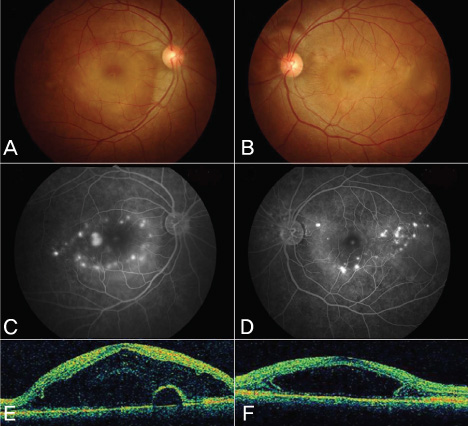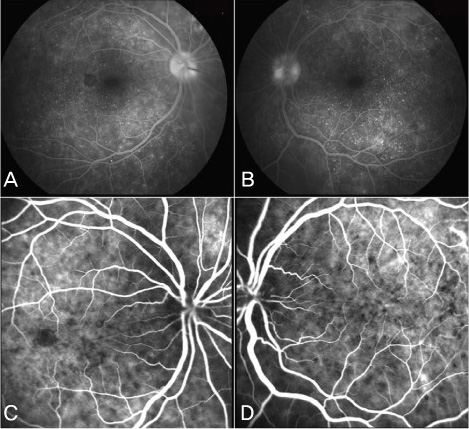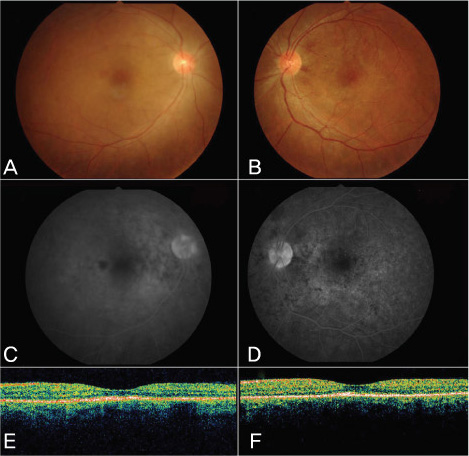Korean J Ophthalmol.
2009 Jun;23(2):112-113. 10.3341/kjo.2009.23.2.112.
A Case of Vogt-Koyanagi-Harada Disease in a Patient With Graves Disease
- Affiliations
-
- 1Department of Ophthalmology, College of Medicine, and Medical Research Center, Seoul National University, Seoul, Korea. hgonyu@ snu.ac.kr
- 2Institute of Research of Sensory Organs, Medical Research Center, Seoul National University, Seoul, Korea.
- 3Department of Ophthalmology, Seoul National University Hospital, Seoul, Korea.
- KMID: 754728
- DOI: http://doi.org/10.3341/kjo.2009.23.2.112
Abstract
- A case of Vogt-Koyanagi-Harada disease (VKH) that developed in a 36-year-old woman with Graves' disease was described. The patient was treated with Lugol's solution and presented with bilateral serous retinal detachment. She had also suffered from methimazole-induced hypersensitivity and steroid-induced myopathy. Fluorescein angiography showed multiple leakage points and a lumbar puncture revealed pleocytosis, which was compatible with VKH. High dose steroid pulse therapy was successful. Altered immune regulation associated with drug-induced hypersensitivity may contribute to the development of VKH in patients with Graves' disease.
Keyword
MeSH Terms
-
Adult
Coloring Agents/administration & dosage
Diagnosis, Differential
Dose-Response Relationship, Drug
Drug Therapy, Combination
Female
Fluorescein Angiography
Follow-Up Studies
Fundus Oculi
Glucocorticoids/administration & dosage
Graves Disease/*complications/diagnosis/drug therapy
Humans
Immunosuppressive Agents/administration & dosage
Injections, Intravenous
Iodides/administration & dosage
Ophthalmic Solutions/administration & dosage
Uveomeningoencephalitic Syndrome/*complications/diagnosis/drug therapy
Figure
Reference
-
1. Read RW, Holland GN, Rao NA, et al. Revised diagnostic criteria for Vogt-Koyanagi-Harada disease: report of an international committee on nomenclature. Am J Ophthalmol. 2001. 131:647–652.2. Chi HI, Furue M, Ishibashi Y. Vogt-Koyanagi-Harada's syndrome associated with Hashimoto's thyroiditis. J Dermatol. 1994. 21:683–686.3. Gocho K, Kondo I, Yamaki K. Identification of autoreactive T cells in Vogt-Koyanagi-Harada disease. Invest Ophthalmol Vis Sci. 2001. 42:2004–2009.4. Streetman DD, Khanderia U. Diagnosis and treatment of Graves Disease. Ann Phamacother. 2003. 37:1100–1109.
- Full Text Links
- Actions
-
Cited
- CITED
-
- Close
- Share
- Similar articles
-
- Vogt-Koyanagi-Harada Syndrome Associated with Psoriasis Vulgaris
- A Case of Vogt-Koyanagi-Harada syndrome presenting initially with recurrent vertigo
- A Case of Vogt-Koyanagi-Harada Syndrome
- A Case of Vogt-Koyanagi-Harada's Syndrome
- Photodynamic Therapy with Verteporfin for Subfoveal Choroidal Neovascularization in Vogt-Koyanagi-Harada Syndrome




